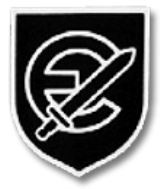
Battle of Porkuni
Encyclopedia
Battle of Porkuni was the largest engagement between Estonians serving in the Red Army
and Estonian pro-independence and Waffen-SS units. It took place in 21 September 1944 between Lake Porkuni and the Sauvälja village about seven kilometres northeast of the town of Tamsalu
during the Leningrad Front
's Tallinn Offensive Operation
(17 September 1944 – 26 September 1944).
The 249th Rifle Regiment of the 8th Estonian Rifle Corps
had heavy machine guns and mortars and were supported by artillery
and tank
s. Soldiers of the Estonian Waffen Grenadier Division had only light arms and antitank weapons in the form of German panzerfaust
s.
The 8th Rifle Corps surrounded about 1,500 Estonians retreating from the Tannenberg line in the Sinimäed Hills. In the ensuing battle, more than 500 surrounded Estonians were killed. Around 700 were captured.
Villagers buried 273 dead Estonians in German uniform. Тhe Soviet Rifle Corps lost 73 men killed, of whom 57 had Estonian names.
Red Army
The Workers' and Peasants' Red Army started out as the Soviet Union's revolutionary communist combat groups during the Russian Civil War of 1918-1922. It grew into the national army of the Soviet Union. By the 1930s the Red Army was among the largest armies in history.The "Red Army" name refers to...
and Estonian pro-independence and Waffen-SS units. It took place in 21 September 1944 between Lake Porkuni and the Sauvälja village about seven kilometres northeast of the town of Tamsalu
Tamsalu
Tamsalu is a town in Lääne-Viru County, Estonia, it's the administrativ centre of Tamsalu Parish.-History:The town was first mentioned in 1512, but remained an insignificant village until 1876. After that it was on the railroad line from Tartu to Tallinn...
during the Leningrad Front
Leningrad Front
The Leningrad Front was first formed on August 27, 1941, by dividing the Northern Front into the Leningrad Front and Karelian Front, during the German approach on Leningrad .-History:...
's Tallinn Offensive Operation
Tallinn Offensive Operation
The Tallinn Offensive was a strategic offensive by the Red Army's 2nd Shock and 8th Armies and the Baltic Fleet against the German Army Detachment "Narwa" and pro-independence Estonian units in mainland Estonia on the Eastern Front of World War II on 17–26 September 1944...
(17 September 1944 – 26 September 1944).
The 249th Rifle Regiment of the 8th Estonian Rifle Corps
8th Estonian Rifle Corps
The 8th 'Estonian' Rifle Corps was a formation in the Soviet Army, created on 6 November 1942, during World War II. The 8th 'Estonian' Rifle Corps 1st...
had heavy machine guns and mortars and were supported by artillery
Artillery
Originally applied to any group of infantry primarily armed with projectile weapons, artillery has over time become limited in meaning to refer only to those engines of war that operate by projection of munitions far beyond the range of effect of personal weapons...
and tank
Tank
A tank is a tracked, armoured fighting vehicle designed for front-line combat which combines operational mobility, tactical offensive, and defensive capabilities...
s. Soldiers of the Estonian Waffen Grenadier Division had only light arms and antitank weapons in the form of German panzerfaust
Panzerfaust
The Panzerfaust was an inexpensive, recoilless German anti-tank weapon of World War II. It consisted of a small, disposable preloaded launch tube firing a high explosive anti-tank warhead, operated by a single soldier...
s.
The 8th Rifle Corps surrounded about 1,500 Estonians retreating from the Tannenberg line in the Sinimäed Hills. In the ensuing battle, more than 500 surrounded Estonians were killed. Around 700 were captured.
Villagers buried 273 dead Estonians in German uniform. Тhe Soviet Rifle Corps lost 73 men killed, of whom 57 had Estonian names.

